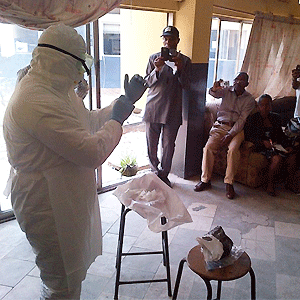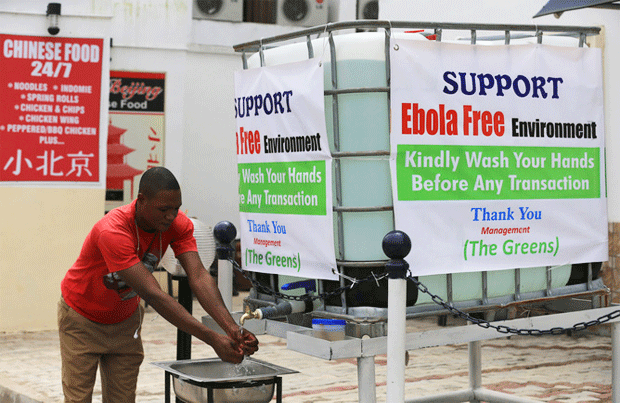
The diagnosis of the first case of Ebola in Lagos, Nigeria in July last year set off alarm bells around the world. The fear was that it would trigger an apocalyptic epidemic that would make the outbreaks in Liberia, Sierra-Leone and Guinea, where 1322 cases were reported and 728 people had died within five months, pale in comparison.
This fear was very justifiable. Lagos has a population of over 21 million with a population density in built up areas of about 20 000 people per square kilometre. In some areas it is as high as 50 000 people per sq km.
But within three months, the most densely populated country on the continent had managed to contain the deadly virus with only eight deaths. By October 20 the World Health Organisation declared Nigeria ebola free. In stark contrast, fourteen months after the first case of ebola was declared in Liberia, the country is celebrating the announcement that it is ebola free.
A combination of factors enabled Nigeria to contain the virus in such a short space of time. These included fast thinking on the part of government, a tried and tested tracking system, pooled expertise and assistance from national and international agencies.
The killer game plan
The disease was brought into the country on July 20 by Patrick Sawyer, a Liberian-American financial consultant. Sawyer initially denied exposure to ebola. He was treated for presumed malaria after suffering from a fever, vomiting and diarrhoea.
Sawyer died five days after his arrival. By then he had triggered a line of exposure. By September, 20 people had been infected. Twelve of whom were in Lagos state and eight in Rivers state. Seven more subsequently died.
In the week that Sawyer was diagnosed, an emergency operation centre was set up. At its core was the system Nigeria had developed for its war against polio and lead poisoning. The deputy manager of the polio campaign was brought in to head the Ebola response team and operations were rapidly scaled up.
The success of the system lies in a strong coordinating team that supervises house-to-house surveillance. A team of 40 trained epidemiologists and 150 contact tracers was mobilised. They drew up a list of all Sawyer’s contacts and those of the subsequent Ebola cases. Locations were mapped and hot spots identified. Fifty teams of contact tracers did house-to-house, in-person visits within a radius of each Ebola contact. In total, they visited 26 000 households in Lagos and Rivers States.
Aside from an initial case assessment, the team also managed the data, infection alerts and rumours, and implemented community-based surveillance.
Five other units backed up their work. These included strategy and coordination, case management and infection control, social mobilisation, laboratory services and points of entry.
The strategy team coordinated the activities of the ministries of health and the international partners, dealt with the media and ensured funding, administrative and logistic support. The social mobilisation team worked on advocacy, dealing with issues of stigma, the psychological and social well-being of contacts and the reintegration of discharged patients into their communities.

All ports of entry were monitored. The temperature of everyone passing through airports, seaports and land borders were checked for potential exposure.
The case management and infection control team treated and managed every laboratory-confirmed or suspected case. Their job was also to prevent the infection being transmitted. This involved training health care workers at treatment centres and health care facilities on how to take precautions and set up screening centres. They also focused on ensuring safe burials.
Good fortune played a part
Good fortune also played a part in limiting the impact of the Sawyer case. Although he had contact with 72 people in the two days before the virus was suspected, only 20 became infected.
It was also fortunate that Sawyer arrived by plane rather than on congested public transport. If he had travelled by land he would have been in close proximity to a great many more people. Passengers would have got on and off at stops along the way, increasing the risk of exposure significantly.
His diplomatic status was also a major bonus. It meant that he was taken straight to a private hospital by diplomatic staff where he was nursed in a private room and diagnosed by an astute clinician.
It was also good fortune that Sawyer landed in Lagos state which has a disease surveillance system in place and facilities at the federal teaching hospital to make the laboratory diagnosis.
Managing the message to kill the panic
In the hours and days following news of Sawyer’s diagnosis, fear, myths and rumours spread like wild fire. Much of this was fanned by the press. This led to health care workers refusing to treat any bleeding or feverish patients.
The strategy team brought things under control by engaging the media, communities and key opinion leaders. A multi-pronged plan was put in place. Health care workers in communities were given hands on training about standard precautions and infection prevention. Protective equipment was also made available to health care centres in the communities.
Simple messages were developed that considered the available resources at health care facilities. In some instances, it was as basic as placing a chair at the end of a hospital corridor and cordoning off an area so that suspected cases could be isolated from other patients.
There was also a concerted effort to educate the media and to keep people informed. Daily briefings on patient recovery helped reduce fear.
Despite the tragedy, the ebola outbreak proved how important it is to rapidly respond to an outbreak with a unified plan, backed up with expertise, manpower and a health system with effective infection controls.
But equally important was the lesson in national unity evident in the unprecedented co-operation between the Nigerian public and private sectors, teaching hospitals, universities and volunteers. It was a massive team effort led by Nigerians assisted by the international agencies. Nigeria proved the pundits wrong.![]()
Folasade Ogunsola is Professor of Clinical Microbiology at University of Lagos.
This article was originally published on The Conversation. Read the original article.
Read more:
Man spreads Ebola via sex 5 months after cured
New Ebola test gives results in 11 minutes
Nigeria finds an H5 strain of bird flu in poultry




 Publications
Publications
 Partners
Partners















